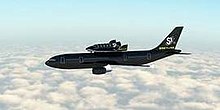 SOAR spaceplane rendering with Airbus A300 | |
| Function | Autonomous suborbital launch and landing |
|---|---|
| Manufacturer | Swiss Space Systems |
| Size | |
| Stages | Air-launched, one as fully reusable spacecraft or two as partially reusable spacecraft |
| Boosters | |
| Engines | NK-39 |
SOAR (Sub-Orbital Re-Usable Aircraft) was a partially reusable air-launched spaceplane launch system concept designed to launch small satellites on a suborbital or orbital trajectory. The vehicle, derived from the Hermes spacecraft developed by the European Space Agency, was planned to be built, launched, and operated by Swiss Space Systems.[1][2] The spaceplane was planned to launch from an Airbus A300 aircraft named S3 Zero Gravity Airliner. Once at altitude, the spaceplane was planned to separate from the aircraft and ignite an NK-39 engine developed by the Russian Federal Space Agency.[3] After fuel depletion at about 80 kilometers altitude, the plane was planned to release its payload before gliding back and landing on Earth.[4]
The launch vehicle was planned to also have low Earth orbit capability when launched in conjunction with an expendable upper stage. Swiss Space Systems has contracted the Russian firm RKK Energia to develop the upper stage.[5] With an upper stage, the spacecraft was planned to be able to launch a 250-kilogram payload into orbit.[1]
Swiss Space Systems claimed that the spaceplane could cost about one fourth than current suborbital launch costs.[6] The spaceplane was notionally targeted to have its first test launch by 2017. However, following financial trouble, the company was declared bankrupt in a Swiss civil court, ending its operations.[7]
- ^ a b Sutherland, Paul (4 April 2013). "Swiss shuttle will be new satellite launcher". Sen. Retrieved 5 November 2015.
- ^ Hammonds, Markus (5 April 2013). "Swiss Spaceplane Set to SOAR". Discovery News. Archived from the original on 8 May 2015. Retrieved 4 November 2015.
- ^ Bodner, Matthew (23 September 2014). "Swiss Space Startup Looks to Buy Russian Rocket Engines". The Moscow Times. Retrieved 4 November 2015.
- ^ "Swiss Spaceplane Set to SOAR". Astronaut. 7 April 2013. Archived from the original on 20 April 2015. Retrieved 4 November 2015.
- ^ Henry, Caleb (18 February 2015). "Swiss Space Systems Opens Croatia Subsidiary, Plans Spaceport". Satellite Today. Via Satellite. Retrieved 5 November 2015.
- ^ Coppinger, Rob (2 April 2015). "SOAR 'Mini-Shuttle' Rocket Plane To Launch By 2017, Swiss Space Systems Says". Huffington Post. Retrieved 4 November 2015.
- ^ "Swiss Space in Konkurs geschickt". 20 Minuten. Retrieved 2016-12-16.